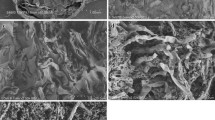Abstract
Immobilization of enzymes is valuably important as it improves the stability and hence increases the reusability of enzymes. The present investigation is an attempt for immobilization of purified glucose-6-phosphate dehydrogenase from pigeon pea on different matrix. Maximum immobilization was achieved when alginate was used as immobilization matrix. As compared to soluble enzyme the alginate immobilized enzyme exhibited enhanced optimum pH and temperature. The alginate immobilized enzyme displayed more than 80% activity up to 7 continuous reactions and more than 50% activity up to 11 continuous reactions.



Similar content being viewed by others
Abbreviations
- G6PD:
-
Glucose-6-phosphate dehydrogenase
- NADP+ :
-
Nicotinamide adenine dinucleotide phosphate (oxidized)
- NADPH:
-
Nicotinamide adenine dinucleotide phosphate (reduced)
- ATP:
-
Adenosine triphosphate
References
Zucca P, Sanjust E (2014) Inorganic materials as supports for covalent enzyme immobilization: methods and mechanisms. Molecules 19:14139–14194
Zucca P, Fernandez-Lafuente R, Sanjust E (2016) Agarose and its derivatives as supports for enzyme immobilization. Molecules 21(11):1577
Srivastava PK, Singh S (2013) Immobilization and applications of glucose-6-phosphate dehydrogenase: a review. J Prep Biochem Biotech 43:376–384
Nelson JM, Griffin EC (1916) Adsorption of Invertase. J Am Chem Soc 38:1109–1115
Grubhofer N, Schleith L (1953) Modified ion exchangers as specific adsorbents. Naturwissenschaften 40:508–512
Grubhofer N, Schleith L (1954) The coupling of proteins to diazotized poly (amminostyrene). Z Physiol Chem 29:108
Hartmeier W (1988) Immobilized biocatalysts: an introduction. Springer-Verlag, Berlin
Torchilin VP (1987) Immobilized enzymes as drugs. Adv Drug Deliv Rev 1:41–86
Prachl JT, Gregg XT (2005) Red cell enzymes. Hematology 1:19–23
Greene LS (1993) Deficiency as protection against falciparum malaria: an epidemiological critique of population and experimental studies. Yearbook Phys Anthropol 36:153–178.
Jain M, Brenner DA, Cui L, Lim CC, Wang B, Pimentel DR, Koh S, Sawyer DB, Leopold JA, Handy DE, Loscalzo J, Apstein CS, Liao R (2003) Glucose-6-phosphate dehydrogenase modulator cytosolic redox status and contractile phenotype in adult cardiomyocytes. Circ Res 93(2):e9–e16
Luzzatto L, Battistuzzi G (1985) Glucose-6-phosphate dehydrogenase variants. Adv Hum Genet 14:217–329
Fenu MP, Finazzi G, Manoussakis C, Palomba V, Fiorelli G (1982) Glucose-6-phosphate dehydrogenase deficiency: genetic heterogeneity in Sardinia. Ann Hum Genet 46:105–114
Peiretti E, Mandas A, Cocco P, Norfo C, Abete C, Angius F, Pani A, Vascellari S, Del Fiacco G, Cannas D, Diaz G, Dessì S, Fossarello M (2010) Glucose-6-phosphate-dehydrogenase deficiency as a risk factor for pterygium. Invest Ophthal Vis Sci 51:2928–2935
Beutler E (1983) Glucose 6-phosphate Dehydrogenase. In: Stanbury JB, Wyngaarden JB, Fredrickson DJ, Goldstein JL, Brown MS (eds) The metabolic basis of inherited disease. McGraw-Hill, New York, pp 1629–1653
Luzzatto L (1979) Genetics of red cells and susceptibility to malaria. Blood 54:961–976
Luzzatto L, Bienzle U (1979) The malaria-G6PD hypothesis. The Lancet 1:1183–1184
Ruwende C, Hill A (1998) Glucose 6-phosphate dehydrogenase deficiency and malaria. J Mol Med 76:581–588
Dennery PA, Seidman DS, Stevenson DK (2001) Neonatal hyperbilirubinemia. N Engl J Med 344:581–590
Mehta A, Mason PJ, Vulliamy TJ (2000) Glucose-6-phosphate dehydrogenase deficiency. Best Pract Res Clin Haematol 13:21–38
Kotorman M, Simon LM, Szajani B (1994) Coenzyme production using immobilized enzymes.III. Immobilization of glucose-6-phosphate dehydrogenase from bakers’ yeast. Enzyme Microb Technol 16:974–978
Zaitseva EA, Chukhari ES, Poltorak OM (2000) Stabilization mechanism of glucose-6-phosphate dehydrogenase. Biocatal Suppl 41:127–129
Reclos GJ, Schulpis KH, Gavrili S, Vlachos G (2003) Evaluation of glucose-6-phosphate dehydrogenase activity in two different ethnic groups using a kit employing the haemoglobin normalization procedure. Clin Biochem 36:393–395
Tzang CH, Yuan R, Yang MS (2001) Voltametric biosensors for the determination of formate and glucose-6-phosphate dehydrogenase based on the measurement of dehydrogenase-generated NADH and NADPH. Biosens Bioelectron 16:211–219
Cui Y, Barford JP, Renneberg R (2007) Development of an interference free biosensor for glucose-6-phosphate using a bienzyme based clark-type electrode. Sens Actuators B 123:696–700
Cui Y, Barford JP, Renneberg R (2008) Amperometric trienzyme ATP biosensors based on the coimmobilization of salicylate hydroxylase, glucose-6-phosphate dehydrogenase and hexokinase. Sens Actuators B 132:1–4
Tanvir S, Pantigny J, Boulnois P, Pulvin S (2009) Covalent immobilization of recombinant human cytochrome CYP2E1 and glucose-6-phosphate dehydrogenase in alumina membrane for drug screening application. J Membr Sci 329:85–90
Singh S, Srivastava PK (2014) Purification and characterization of glucose-6-phosphate dehydrogenase from pigeon pea (Cajanus cajan) seeds. Adv Enz Res 2:134–149
Lowry OH, Rosebrough NJ, Farr AL, Randall PJ (1951) Protein measurement with the Folin protein reagent. J Biol Chem 193:265–275
Araki C (1937) Acetylation of agar like substance of Gelidium amansii. J Chem Soc Jpn 58:1338–1350
Araki C (1956) Structure of the agarose constituent of agar–agar. Bull Chem Soc Jpn 29:543–544
Lee KY, Mooney DJ (2012) Alginate: properties and biomedical applications. Prog Polym Sci 37(1): 106–126
Margarethe P, Schaaf M, Heide LE, Eckhard W, Leisrjer YT, El-Olemy MM (1993) Immobilization of isochorismate hydroxymutase. Comparison of native versus immobilized enzyme. J Nat Prod 56(8):1304–1312
Moore CM, Akers NL, Hill AD, Johnson ZC, Minteer SD (2004) Improving the environment for immobilized dehydrogenase enzymes by modifying nafion with tetraalkylammonium bromides. Biomacromolecules 5(4):1241–1247
Singh S, Anand A, Srivastava PK (2012) Regulation and properties of glucose-6-phosphate dehydrogenase: a review. Int J P Physiol Biochem 4(1):1–19
Acknowledgements
Author is highly grateful to Department of Biotechnology, Government of India for providing research grant BT/04/NE/2009 under the project “Institutional Biotechnology Hub” at College of Horticulture & Forestry, Central Agricultural University, Pasighat-791102, Arunachal Pradesh.
Author information
Authors and Affiliations
Corresponding author
Ethics declarations
Conflict of interest
The authors declare that they have no conflicts of interest.
Ethical Approval
This article does not contain any studies with human participants or animals performed by any of the authors.
Rights and permissions
About this article
Cite this article
Singh, S., Singh, A.K., Singh, M.C. et al. Immobilization Increases the Stability and Reusability of Pigeon Pea NADP+ Linked Glucose-6-Phosphate Dehydrogenase. Protein J 36, 49–55 (2017). https://doi.org/10.1007/s10930-017-9702-5
Published:
Issue Date:
DOI: https://doi.org/10.1007/s10930-017-9702-5




